Derivatives and Alternative Investments: Financial Crisis Report
VerifiedAdded on 2023/01/19
|19
|5087
|66
Report
AI Summary
This report provides an executive summary and detailed analysis of derivatives and alternative investments, with a specific focus on their role in the 2008 financial crisis. The report explores various financial instruments, including bonds, futures, and options, and examines their impact on the market. Section A covers bond duration, forward pricing, and option valuation. Section B delves into the functions of financial centers, the benefits and risks of futures and options, and the tools used for assessing and managing risk in derivative trading. The report highlights the contribution of aggressive derivative trading to the collapse of banks like Lehman Brothers and the steps of risk management that could have prevented the financial crisis. The analysis includes currency futures and options, their benefits, and associated risks. The report emphasizes the importance of understanding market fluctuations and the role of derivatives in both mitigating and exacerbating financial risks.
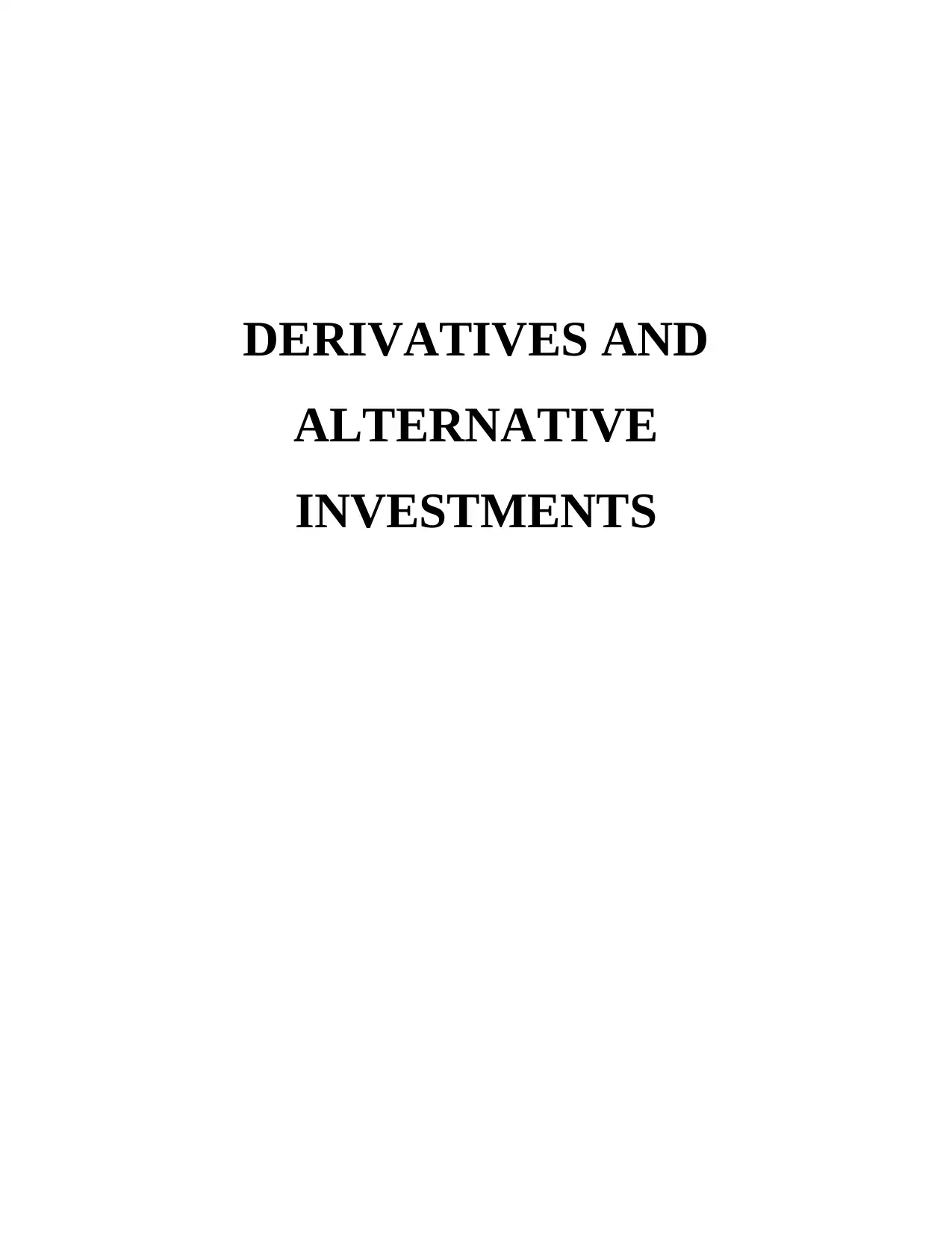
DERIVATIVES AND
ALTERNATIVE
INVESTMENTS
ALTERNATIVE
INVESTMENTS
Paraphrase This Document
Need a fresh take? Get an instant paraphrase of this document with our AI Paraphraser
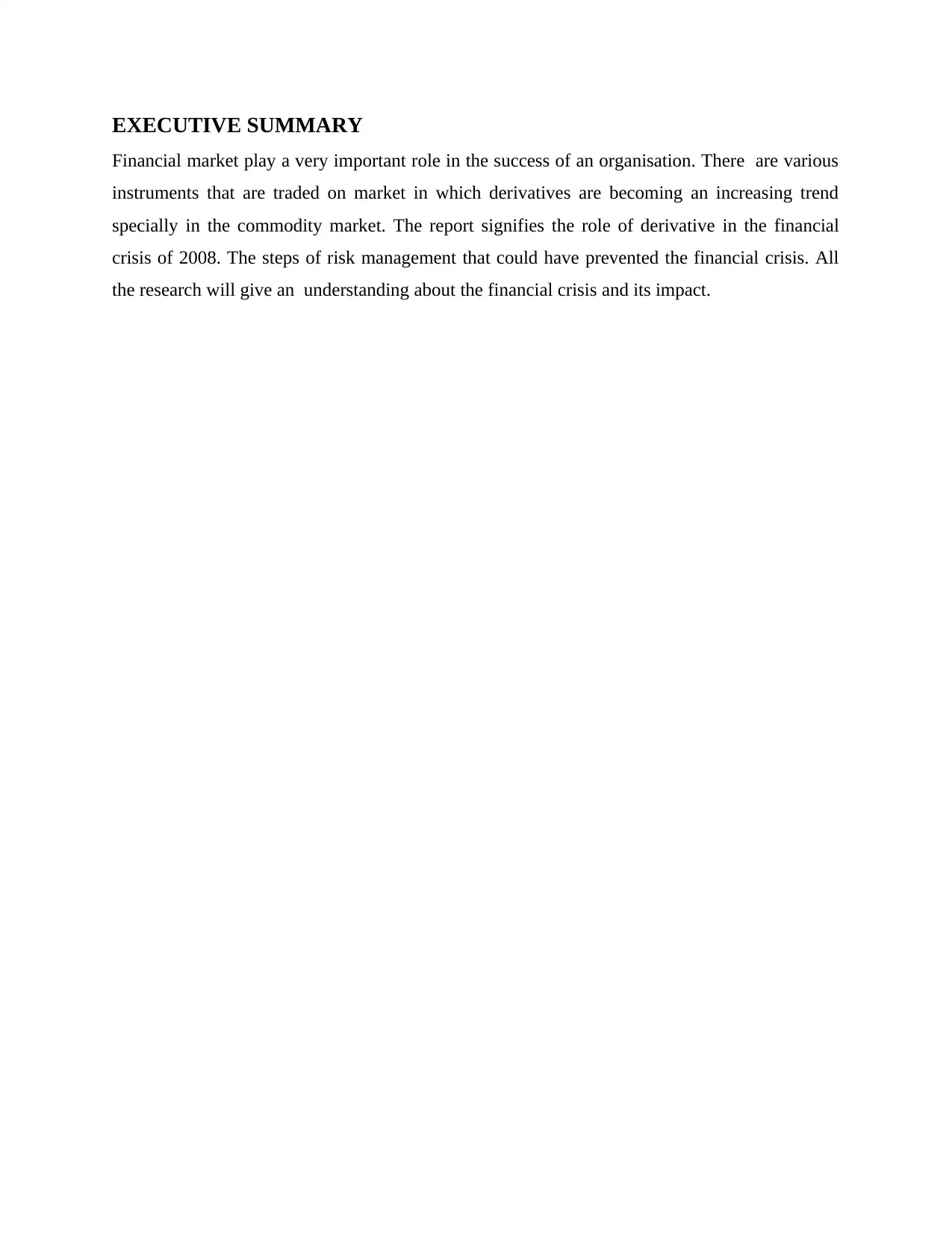
EXECUTIVE SUMMARY
Financial market play a very important role in the success of an organisation. There are various
instruments that are traded on market in which derivatives are becoming an increasing trend
specially in the commodity market. The report signifies the role of derivative in the financial
crisis of 2008. The steps of risk management that could have prevented the financial crisis. All
the research will give an understanding about the financial crisis and its impact.
Financial market play a very important role in the success of an organisation. There are various
instruments that are traded on market in which derivatives are becoming an increasing trend
specially in the commodity market. The report signifies the role of derivative in the financial
crisis of 2008. The steps of risk management that could have prevented the financial crisis. All
the research will give an understanding about the financial crisis and its impact.
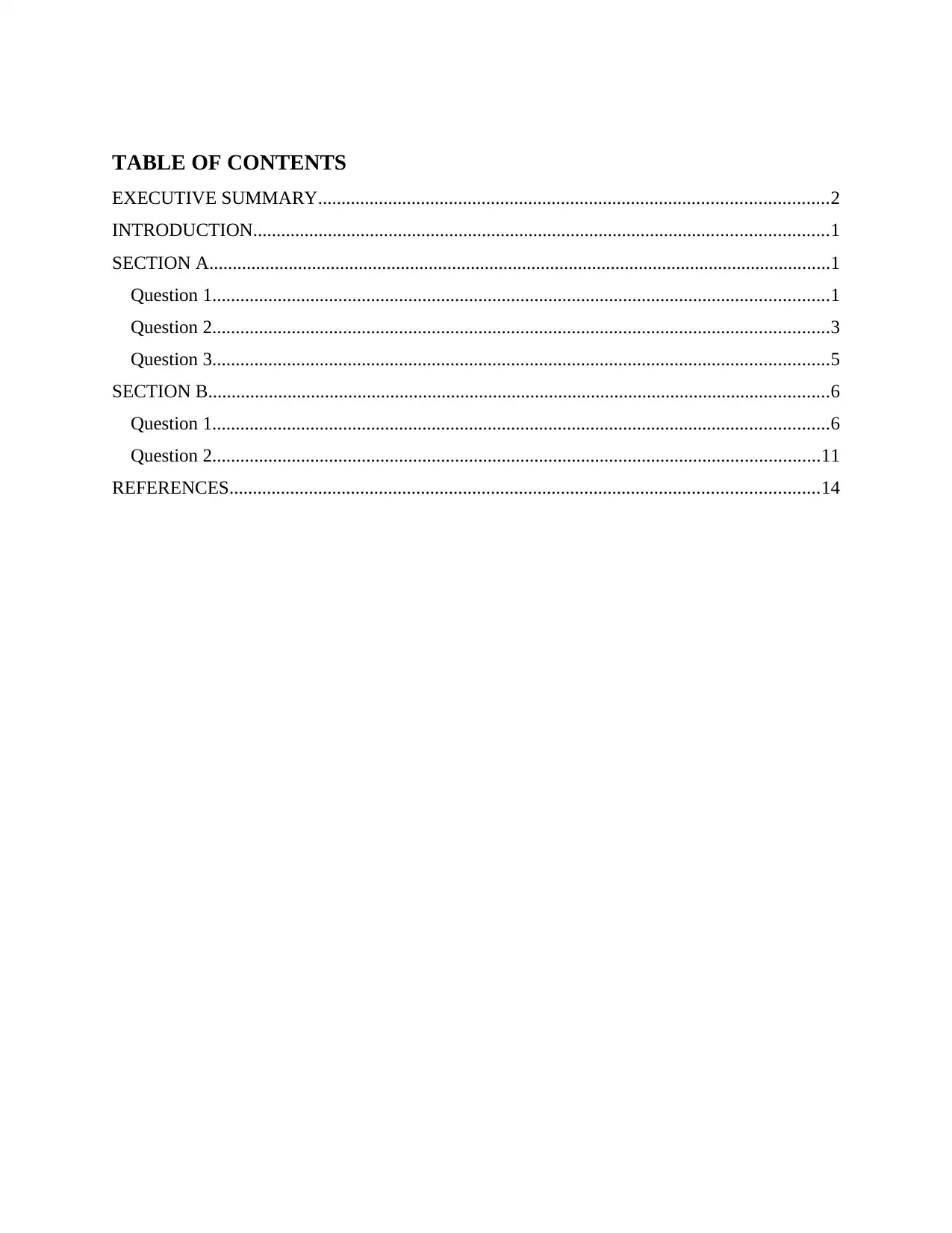
TABLE OF CONTENTS
EXECUTIVE SUMMARY.............................................................................................................2
INTRODUCTION...........................................................................................................................1
SECTION A.....................................................................................................................................1
Question 1....................................................................................................................................1
Question 2....................................................................................................................................3
Question 3....................................................................................................................................5
SECTION B.....................................................................................................................................6
Question 1....................................................................................................................................6
Question 2..................................................................................................................................11
REFERENCES..............................................................................................................................14
EXECUTIVE SUMMARY.............................................................................................................2
INTRODUCTION...........................................................................................................................1
SECTION A.....................................................................................................................................1
Question 1....................................................................................................................................1
Question 2....................................................................................................................................3
Question 3....................................................................................................................................5
SECTION B.....................................................................................................................................6
Question 1....................................................................................................................................6
Question 2..................................................................................................................................11
REFERENCES..............................................................................................................................14
⊘ This is a preview!⊘
Do you want full access?
Subscribe today to unlock all pages.

Trusted by 1+ million students worldwide
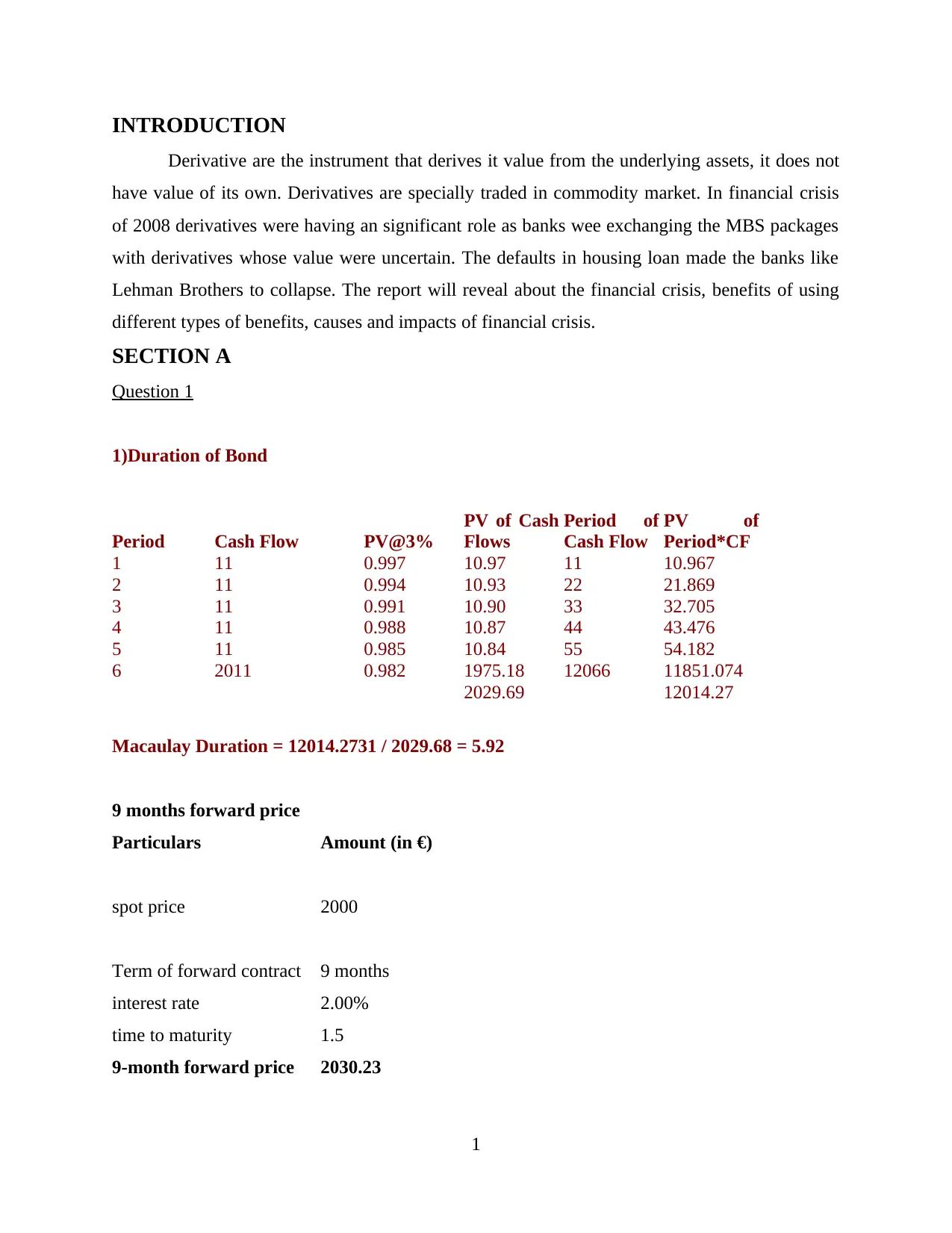
INTRODUCTION
Derivative are the instrument that derives it value from the underlying assets, it does not
have value of its own. Derivatives are specially traded in commodity market. In financial crisis
of 2008 derivatives were having an significant role as banks wee exchanging the MBS packages
with derivatives whose value were uncertain. The defaults in housing loan made the banks like
Lehman Brothers to collapse. The report will reveal about the financial crisis, benefits of using
different types of benefits, causes and impacts of financial crisis.
SECTION A
Question 1
1)Duration of Bond
Period Cash Flow PV@3%
PV of Cash
Flows
Period of
Cash Flow
PV of
Period*CF
1 11 0.997 10.97 11 10.967
2 11 0.994 10.93 22 21.869
3 11 0.991 10.90 33 32.705
4 11 0.988 10.87 44 43.476
5 11 0.985 10.84 55 54.182
6 2011 0.982 1975.18 12066 11851.074
2029.69 12014.27
Macaulay Duration = 12014.2731 / 2029.68 = 5.92
9 months forward price
Particulars Amount (in €)
spot price 2000
Term of forward contract 9 months
interest rate 2.00%
time to maturity 1.5
9-month forward price 2030.23
1
Derivative are the instrument that derives it value from the underlying assets, it does not
have value of its own. Derivatives are specially traded in commodity market. In financial crisis
of 2008 derivatives were having an significant role as banks wee exchanging the MBS packages
with derivatives whose value were uncertain. The defaults in housing loan made the banks like
Lehman Brothers to collapse. The report will reveal about the financial crisis, benefits of using
different types of benefits, causes and impacts of financial crisis.
SECTION A
Question 1
1)Duration of Bond
Period Cash Flow PV@3%
PV of Cash
Flows
Period of
Cash Flow
PV of
Period*CF
1 11 0.997 10.97 11 10.967
2 11 0.994 10.93 22 21.869
3 11 0.991 10.90 33 32.705
4 11 0.988 10.87 44 43.476
5 11 0.985 10.84 55 54.182
6 2011 0.982 1975.18 12066 11851.074
2029.69 12014.27
Macaulay Duration = 12014.2731 / 2029.68 = 5.92
9 months forward price
Particulars Amount (in €)
spot price 2000
Term of forward contract 9 months
interest rate 2.00%
time to maturity 1.5
9-month forward price 2030.23
1
Paraphrase This Document
Need a fresh take? Get an instant paraphrase of this document with our AI Paraphraser
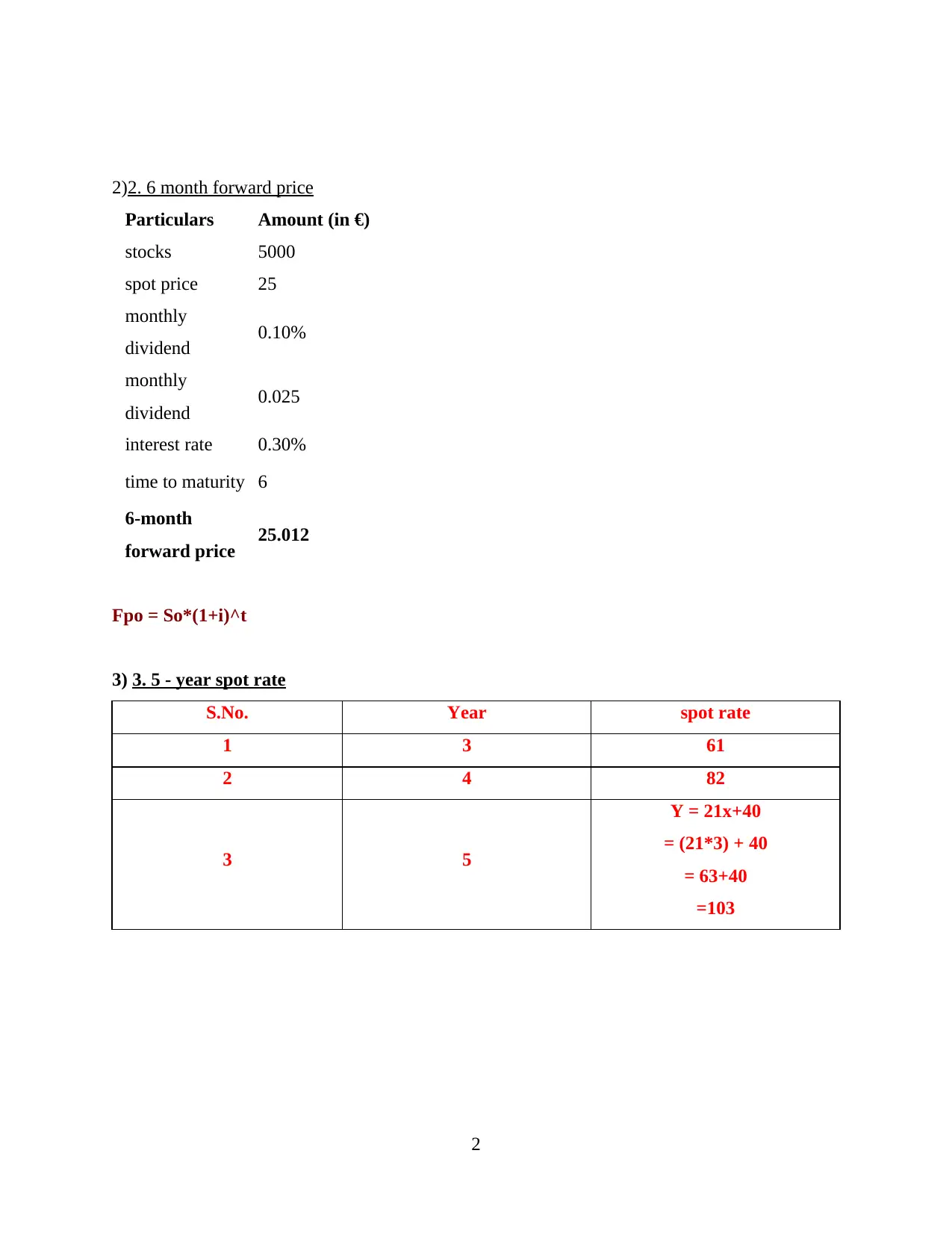
2)2. 6 month forward price
Particulars Amount (in €)
stocks 5000
spot price 25
monthly
dividend 0.10%
monthly
dividend 0.025
interest rate 0.30%
time to maturity 6
6-month
forward price 25.012
Fpo = So*(1+i)^t
3) 3. 5 - year spot rate
S.No. Year spot rate
1 3 61
2 4 82
3 5
Y = 21x+40
= (21*3) + 40
= 63+40
=103
2
Particulars Amount (in €)
stocks 5000
spot price 25
monthly
dividend 0.10%
monthly
dividend 0.025
interest rate 0.30%
time to maturity 6
6-month
forward price 25.012
Fpo = So*(1+i)^t
3) 3. 5 - year spot rate
S.No. Year spot rate
1 3 61
2 4 82
3 5
Y = 21x+40
= (21*3) + 40
= 63+40
=103
2
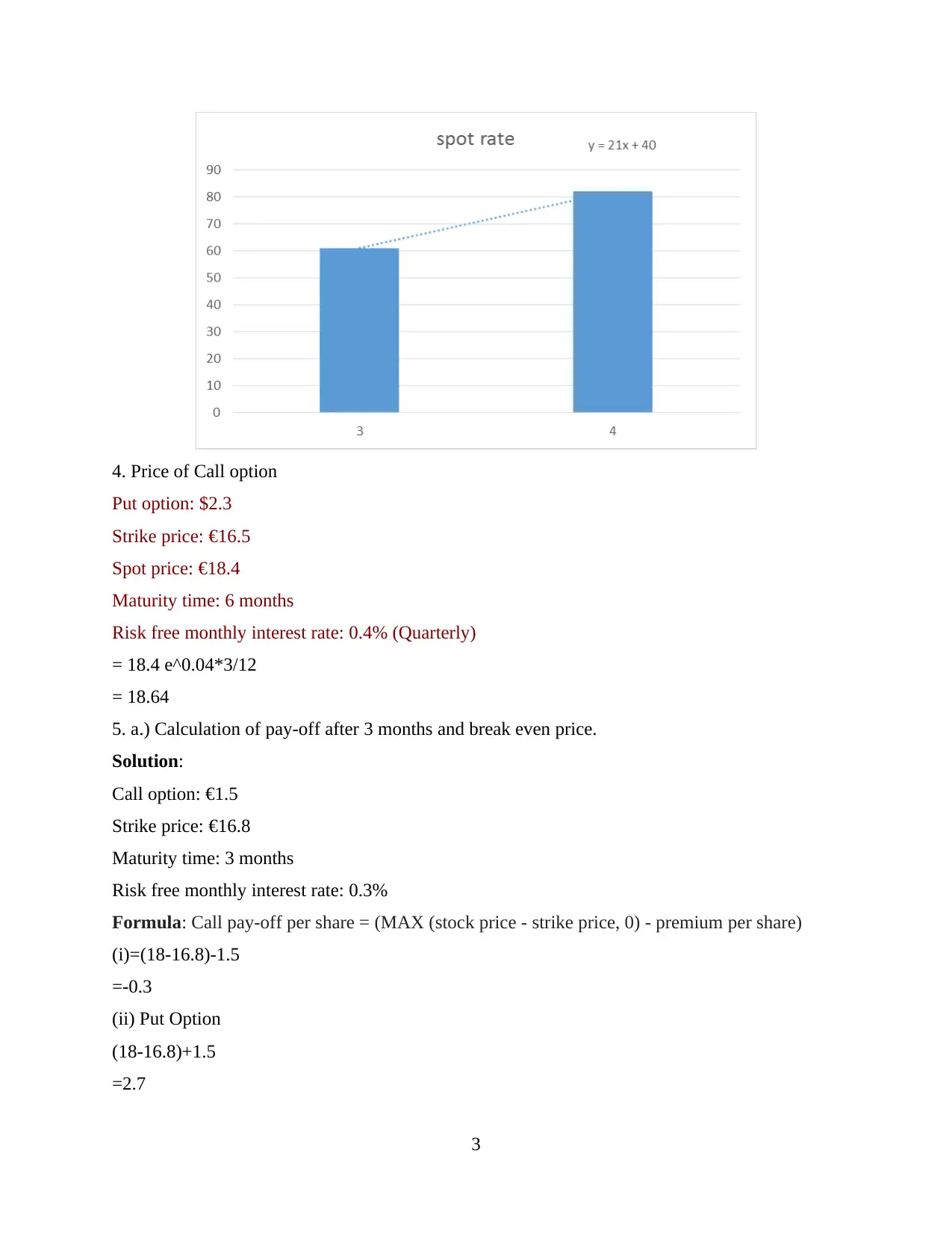
4. Price of Call option
Put option: $2.3
Strike price: €16.5
Spot price: €18.4
Maturity time: 6 months
Risk free monthly interest rate: 0.4% (Quarterly)
= 18.4 e^0.04*3/12
= 18.64
5. a.) Calculation of pay-off after 3 months and break even price.
Solution:
Call option: €1.5
Strike price: €16.8
Maturity time: 3 months
Risk free monthly interest rate: 0.3%
Formula: Call pay-off per share = (MAX (stock price - strike price, 0) - premium per share)
(i)=(18-16.8)-1.5
=-0.3
(ii) Put Option
(18-16.8)+1.5
=2.7
3
Put option: $2.3
Strike price: €16.5
Spot price: €18.4
Maturity time: 6 months
Risk free monthly interest rate: 0.4% (Quarterly)
= 18.4 e^0.04*3/12
= 18.64
5. a.) Calculation of pay-off after 3 months and break even price.
Solution:
Call option: €1.5
Strike price: €16.8
Maturity time: 3 months
Risk free monthly interest rate: 0.3%
Formula: Call pay-off per share = (MAX (stock price - strike price, 0) - premium per share)
(i)=(18-16.8)-1.5
=-0.3
(ii) Put Option
(18-16.8)+1.5
=2.7
3
⊘ This is a preview!⊘
Do you want full access?
Subscribe today to unlock all pages.

Trusted by 1+ million students worldwide

Question 2
Financial centres refers to service financial service centre having direct access over big
capital pool from insurance, banks, investment funds and markets that are listed over exchange.
Financial centres refers to location with collection of participants in asset management, banking,
financial markets or insurance with support services for the activities. Future markets are
playing critical and important of strong economy. This is having different roles for playing. It
has to fulfil requirements of different market players which are involved in market.
Future trading involves two parties that agree on transacting over financial instruments
or commodity at future date over price that is agreed in present. Contract is drawn on terms at
future transaction, and parties have to abide by contract. Futures are derivative instrument as
values are derived underlying assets and they do not have value of their own. Examples of
underlying assets are corn, wheat, gold and securities. Asset whose prices are vulnerable and
have excessive volatility are best for future trade.
Price fluctuations affects every aspect of economy. Futures are generally used for
commodity markets as today markets are very deviating that affects the prices of commodities.
Trading in commodity futures requires detailed understanding & experience. The future markets
protect the investors from suffering losses due to price fluctuations in the market. As they have
to pat only the premium prices in case of losing the contract. Investing in futures market has
become an rising trend attracting large number of investors. This is helping to attract the
revenues for the companies and stock market centres have regained the investors who made a
shift from the investor market due to fluctuations in securities market.
Benefits of securities market
Most important advantage of future markets is that businesses and individuals are
allowed to protect the positions against future price fluctuations. It provide protections to buyers
against the future price increase and it provides protection to seller against the future price falls.
Derivatives are securities that derive their value from an underlying asset or benchmark.
Common derivatives include futures contracts, forwards, options, and swaps. Most derivatives
are not traded on exchanges and are used by institutions to hedge risk or speculate on price
changes in the underlying asset. The derivatives can also be define as the contract in which two
or more parties are being involved. The derivative prices can be taken from assets which are
underlying and fluctuating. The assets which are included in derivatives are stocks, bonds,
4
Financial centres refers to service financial service centre having direct access over big
capital pool from insurance, banks, investment funds and markets that are listed over exchange.
Financial centres refers to location with collection of participants in asset management, banking,
financial markets or insurance with support services for the activities. Future markets are
playing critical and important of strong economy. This is having different roles for playing. It
has to fulfil requirements of different market players which are involved in market.
Future trading involves two parties that agree on transacting over financial instruments
or commodity at future date over price that is agreed in present. Contract is drawn on terms at
future transaction, and parties have to abide by contract. Futures are derivative instrument as
values are derived underlying assets and they do not have value of their own. Examples of
underlying assets are corn, wheat, gold and securities. Asset whose prices are vulnerable and
have excessive volatility are best for future trade.
Price fluctuations affects every aspect of economy. Futures are generally used for
commodity markets as today markets are very deviating that affects the prices of commodities.
Trading in commodity futures requires detailed understanding & experience. The future markets
protect the investors from suffering losses due to price fluctuations in the market. As they have
to pat only the premium prices in case of losing the contract. Investing in futures market has
become an rising trend attracting large number of investors. This is helping to attract the
revenues for the companies and stock market centres have regained the investors who made a
shift from the investor market due to fluctuations in securities market.
Benefits of securities market
Most important advantage of future markets is that businesses and individuals are
allowed to protect the positions against future price fluctuations. It provide protections to buyers
against the future price increase and it provides protection to seller against the future price falls.
Derivatives are securities that derive their value from an underlying asset or benchmark.
Common derivatives include futures contracts, forwards, options, and swaps. Most derivatives
are not traded on exchanges and are used by institutions to hedge risk or speculate on price
changes in the underlying asset. The derivatives can also be define as the contract in which two
or more parties are being involved. The derivative prices can be taken from assets which are
underlying and fluctuating. The assets which are included in derivatives are stocks, bonds,
4
Paraphrase This Document
Need a fresh take? Get an instant paraphrase of this document with our AI Paraphraser
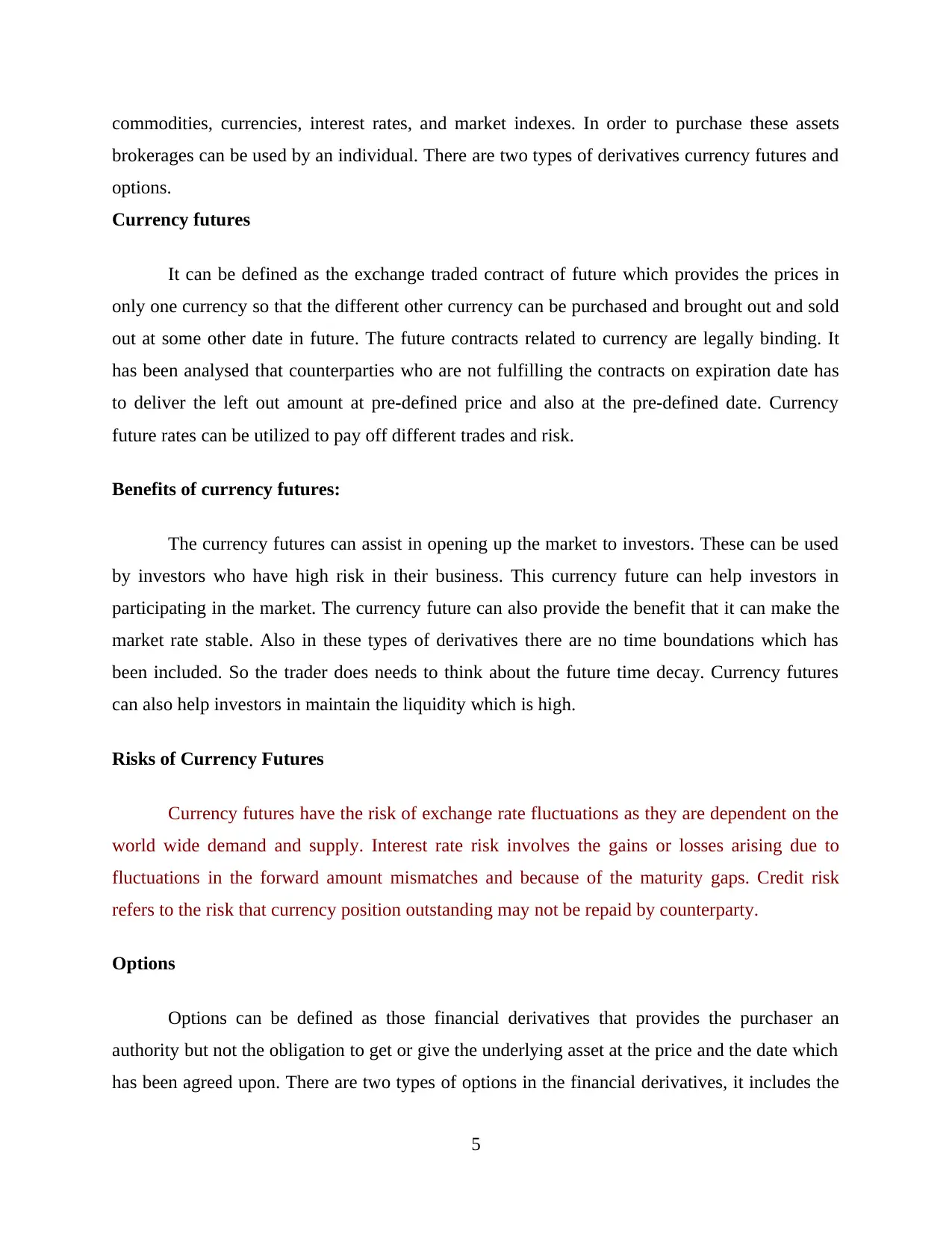
commodities, currencies, interest rates, and market indexes. In order to purchase these assets
brokerages can be used by an individual. There are two types of derivatives currency futures and
options.
Currency futures
It can be defined as the exchange traded contract of future which provides the prices in
only one currency so that the different other currency can be purchased and brought out and sold
out at some other date in future. The future contracts related to currency are legally binding. It
has been analysed that counterparties who are not fulfilling the contracts on expiration date has
to deliver the left out amount at pre-defined price and also at the pre-defined date. Currency
future rates can be utilized to pay off different trades and risk.
Benefits of currency futures:
The currency futures can assist in opening up the market to investors. These can be used
by investors who have high risk in their business. This currency future can help investors in
participating in the market. The currency future can also provide the benefit that it can make the
market rate stable. Also in these types of derivatives there are no time boundations which has
been included. So the trader does needs to think about the future time decay. Currency futures
can also help investors in maintain the liquidity which is high.
Risks of Currency Futures
Currency futures have the risk of exchange rate fluctuations as they are dependent on the
world wide demand and supply. Interest rate risk involves the gains or losses arising due to
fluctuations in the forward amount mismatches and because of the maturity gaps. Credit risk
refers to the risk that currency position outstanding may not be repaid by counterparty.
Options
Options can be defined as those financial derivatives that provides the purchaser an
authority but not the obligation to get or give the underlying asset at the price and the date which
has been agreed upon. There are two types of options in the financial derivatives, it includes the
5
brokerages can be used by an individual. There are two types of derivatives currency futures and
options.
Currency futures
It can be defined as the exchange traded contract of future which provides the prices in
only one currency so that the different other currency can be purchased and brought out and sold
out at some other date in future. The future contracts related to currency are legally binding. It
has been analysed that counterparties who are not fulfilling the contracts on expiration date has
to deliver the left out amount at pre-defined price and also at the pre-defined date. Currency
future rates can be utilized to pay off different trades and risk.
Benefits of currency futures:
The currency futures can assist in opening up the market to investors. These can be used
by investors who have high risk in their business. This currency future can help investors in
participating in the market. The currency future can also provide the benefit that it can make the
market rate stable. Also in these types of derivatives there are no time boundations which has
been included. So the trader does needs to think about the future time decay. Currency futures
can also help investors in maintain the liquidity which is high.
Risks of Currency Futures
Currency futures have the risk of exchange rate fluctuations as they are dependent on the
world wide demand and supply. Interest rate risk involves the gains or losses arising due to
fluctuations in the forward amount mismatches and because of the maturity gaps. Credit risk
refers to the risk that currency position outstanding may not be repaid by counterparty.
Options
Options can be defined as those financial derivatives that provides the purchaser an
authority but not the obligation to get or give the underlying asset at the price and the date which
has been agreed upon. There are two types of options in the financial derivatives, it includes the
5
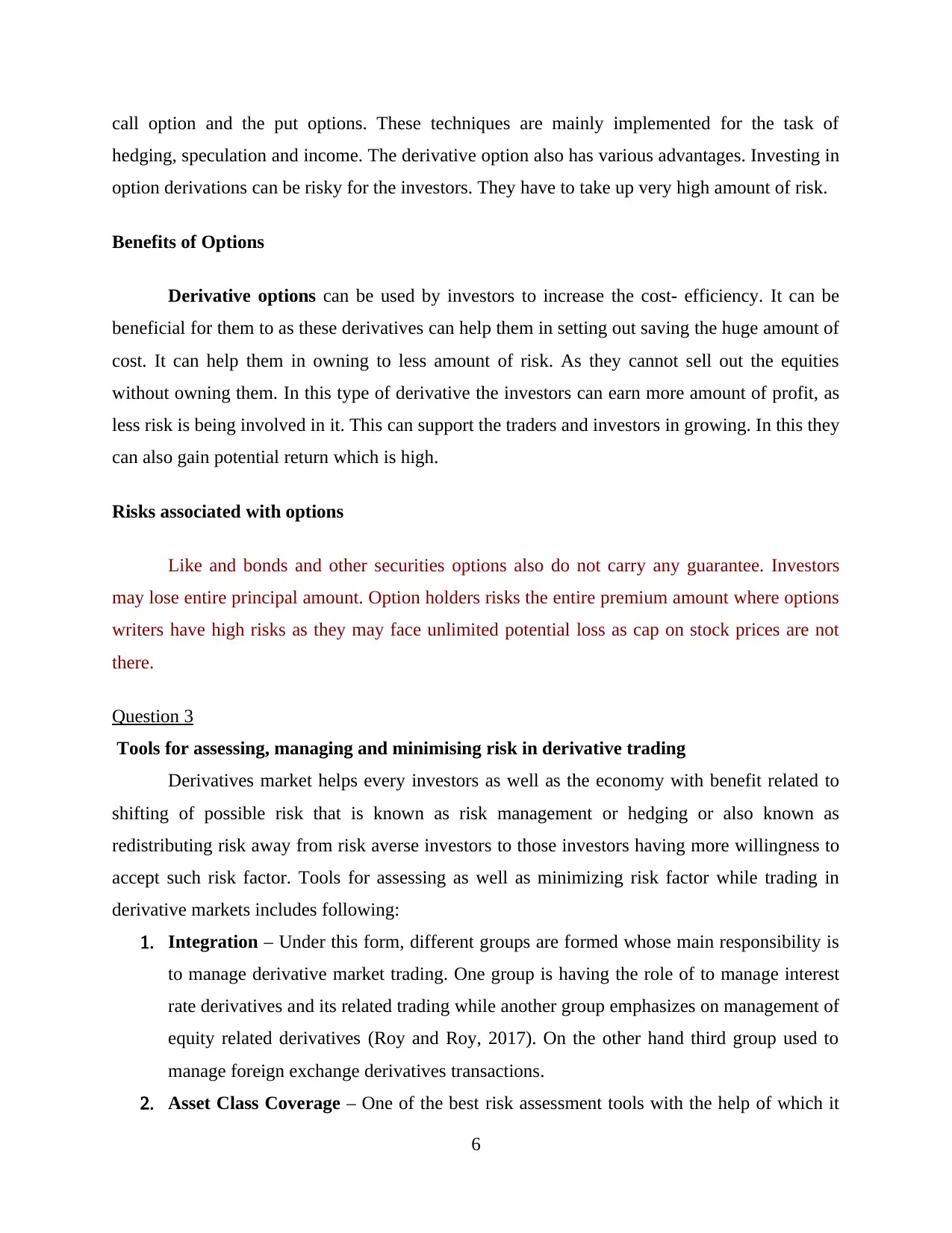
call option and the put options. These techniques are mainly implemented for the task of
hedging, speculation and income. The derivative option also has various advantages. Investing in
option derivations can be risky for the investors. They have to take up very high amount of risk.
Benefits of Options
Derivative options can be used by investors to increase the cost- efficiency. It can be
beneficial for them to as these derivatives can help them in setting out saving the huge amount of
cost. It can help them in owning to less amount of risk. As they cannot sell out the equities
without owning them. In this type of derivative the investors can earn more amount of profit, as
less risk is being involved in it. This can support the traders and investors in growing. In this they
can also gain potential return which is high.
Risks associated with options
Like and bonds and other securities options also do not carry any guarantee. Investors
may lose entire principal amount. Option holders risks the entire premium amount where options
writers have high risks as they may face unlimited potential loss as cap on stock prices are not
there.
Question 3
Tools for assessing, managing and minimising risk in derivative trading
Derivatives market helps every investors as well as the economy with benefit related to
shifting of possible risk that is known as risk management or hedging or also known as
redistributing risk away from risk averse investors to those investors having more willingness to
accept such risk factor. Tools for assessing as well as minimizing risk factor while trading in
derivative markets includes following:
1. Integration – Under this form, different groups are formed whose main responsibility is
to manage derivative market trading. One group is having the role of to manage interest
rate derivatives and its related trading while another group emphasizes on management of
equity related derivatives (Roy and Roy, 2017). On the other hand third group used to
manage foreign exchange derivatives transactions.
2. Asset Class Coverage – One of the best risk assessment tools with the help of which it
6
hedging, speculation and income. The derivative option also has various advantages. Investing in
option derivations can be risky for the investors. They have to take up very high amount of risk.
Benefits of Options
Derivative options can be used by investors to increase the cost- efficiency. It can be
beneficial for them to as these derivatives can help them in setting out saving the huge amount of
cost. It can help them in owning to less amount of risk. As they cannot sell out the equities
without owning them. In this type of derivative the investors can earn more amount of profit, as
less risk is being involved in it. This can support the traders and investors in growing. In this they
can also gain potential return which is high.
Risks associated with options
Like and bonds and other securities options also do not carry any guarantee. Investors
may lose entire principal amount. Option holders risks the entire premium amount where options
writers have high risks as they may face unlimited potential loss as cap on stock prices are not
there.
Question 3
Tools for assessing, managing and minimising risk in derivative trading
Derivatives market helps every investors as well as the economy with benefit related to
shifting of possible risk that is known as risk management or hedging or also known as
redistributing risk away from risk averse investors to those investors having more willingness to
accept such risk factor. Tools for assessing as well as minimizing risk factor while trading in
derivative markets includes following:
1. Integration – Under this form, different groups are formed whose main responsibility is
to manage derivative market trading. One group is having the role of to manage interest
rate derivatives and its related trading while another group emphasizes on management of
equity related derivatives (Roy and Roy, 2017). On the other hand third group used to
manage foreign exchange derivatives transactions.
2. Asset Class Coverage – One of the best risk assessment tools with the help of which it
6
⊘ This is a preview!⊘
Do you want full access?
Subscribe today to unlock all pages.

Trusted by 1+ million students worldwide
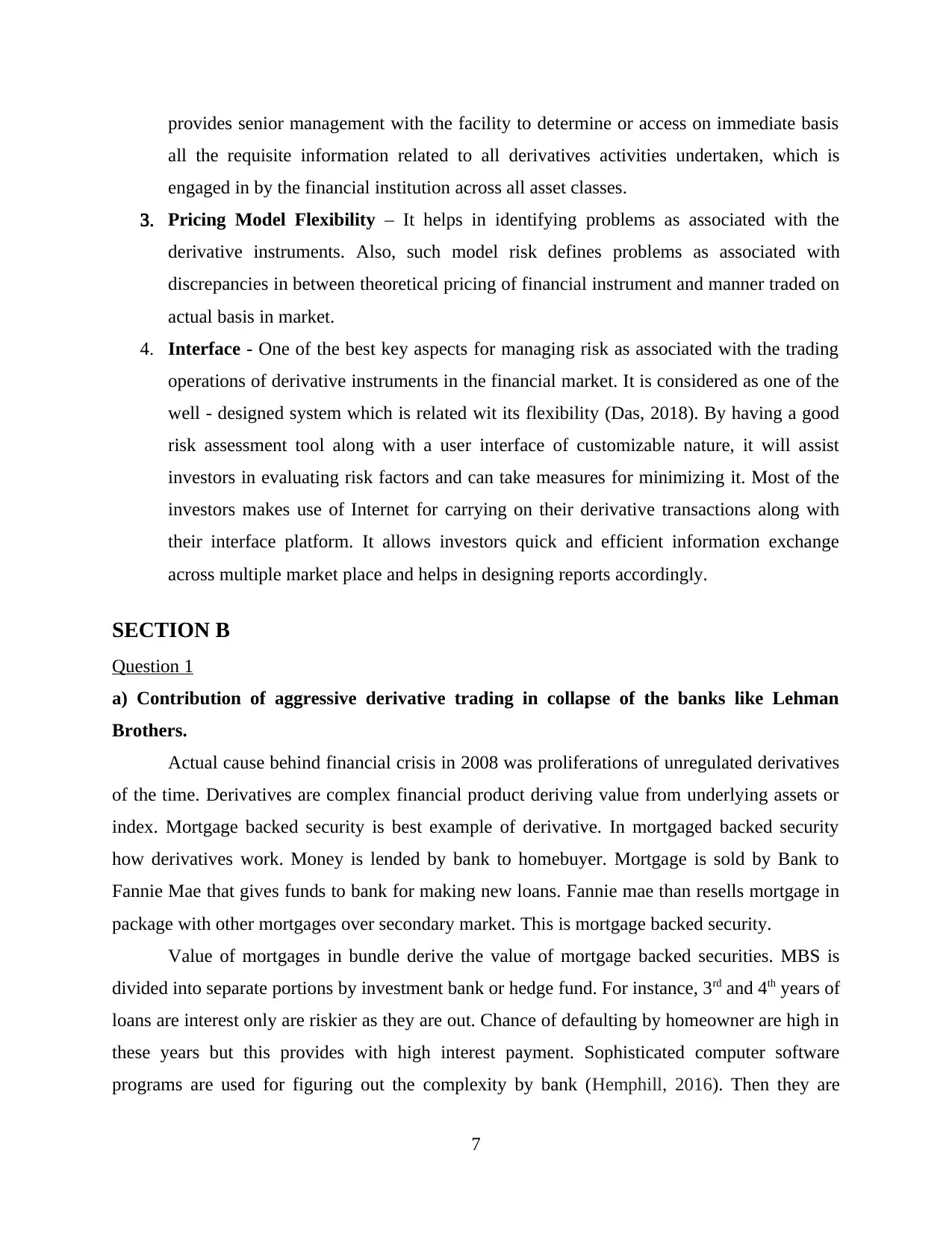
provides senior management with the facility to determine or access on immediate basis
all the requisite information related to all derivatives activities undertaken, which is
engaged in by the financial institution across all asset classes.
3. Pricing Model Flexibility – It helps in identifying problems as associated with the
derivative instruments. Also, such model risk defines problems as associated with
discrepancies in between theoretical pricing of financial instrument and manner traded on
actual basis in market.
4. Interface - One of the best key aspects for managing risk as associated with the trading
operations of derivative instruments in the financial market. It is considered as one of the
well - designed system which is related wit its flexibility (Das, 2018). By having a good
risk assessment tool along with a user interface of customizable nature, it will assist
investors in evaluating risk factors and can take measures for minimizing it. Most of the
investors makes use of Internet for carrying on their derivative transactions along with
their interface platform. It allows investors quick and efficient information exchange
across multiple market place and helps in designing reports accordingly.
SECTION B
Question 1
a) Contribution of aggressive derivative trading in collapse of the banks like Lehman
Brothers.
Actual cause behind financial crisis in 2008 was proliferations of unregulated derivatives
of the time. Derivatives are complex financial product deriving value from underlying assets or
index. Mortgage backed security is best example of derivative. In mortgaged backed security
how derivatives work. Money is lended by bank to homebuyer. Mortgage is sold by Bank to
Fannie Mae that gives funds to bank for making new loans. Fannie mae than resells mortgage in
package with other mortgages over secondary market. This is mortgage backed security.
Value of mortgages in bundle derive the value of mortgage backed securities. MBS is
divided into separate portions by investment bank or hedge fund. For instance, 3rd and 4th years of
loans are interest only are riskier as they are out. Chance of defaulting by homeowner are high in
these years but this provides with high interest payment. Sophisticated computer software
programs are used for figuring out the complexity by bank (Hemphill, 2016). Then they are
7
all the requisite information related to all derivatives activities undertaken, which is
engaged in by the financial institution across all asset classes.
3. Pricing Model Flexibility – It helps in identifying problems as associated with the
derivative instruments. Also, such model risk defines problems as associated with
discrepancies in between theoretical pricing of financial instrument and manner traded on
actual basis in market.
4. Interface - One of the best key aspects for managing risk as associated with the trading
operations of derivative instruments in the financial market. It is considered as one of the
well - designed system which is related wit its flexibility (Das, 2018). By having a good
risk assessment tool along with a user interface of customizable nature, it will assist
investors in evaluating risk factors and can take measures for minimizing it. Most of the
investors makes use of Internet for carrying on their derivative transactions along with
their interface platform. It allows investors quick and efficient information exchange
across multiple market place and helps in designing reports accordingly.
SECTION B
Question 1
a) Contribution of aggressive derivative trading in collapse of the banks like Lehman
Brothers.
Actual cause behind financial crisis in 2008 was proliferations of unregulated derivatives
of the time. Derivatives are complex financial product deriving value from underlying assets or
index. Mortgage backed security is best example of derivative. In mortgaged backed security
how derivatives work. Money is lended by bank to homebuyer. Mortgage is sold by Bank to
Fannie Mae that gives funds to bank for making new loans. Fannie mae than resells mortgage in
package with other mortgages over secondary market. This is mortgage backed security.
Value of mortgages in bundle derive the value of mortgage backed securities. MBS is
divided into separate portions by investment bank or hedge fund. For instance, 3rd and 4th years of
loans are interest only are riskier as they are out. Chance of defaulting by homeowner are high in
these years but this provides with high interest payment. Sophisticated computer software
programs are used for figuring out the complexity by bank (Hemphill, 2016). Then they are
7
Paraphrase This Document
Need a fresh take? Get an instant paraphrase of this document with our AI Paraphraser
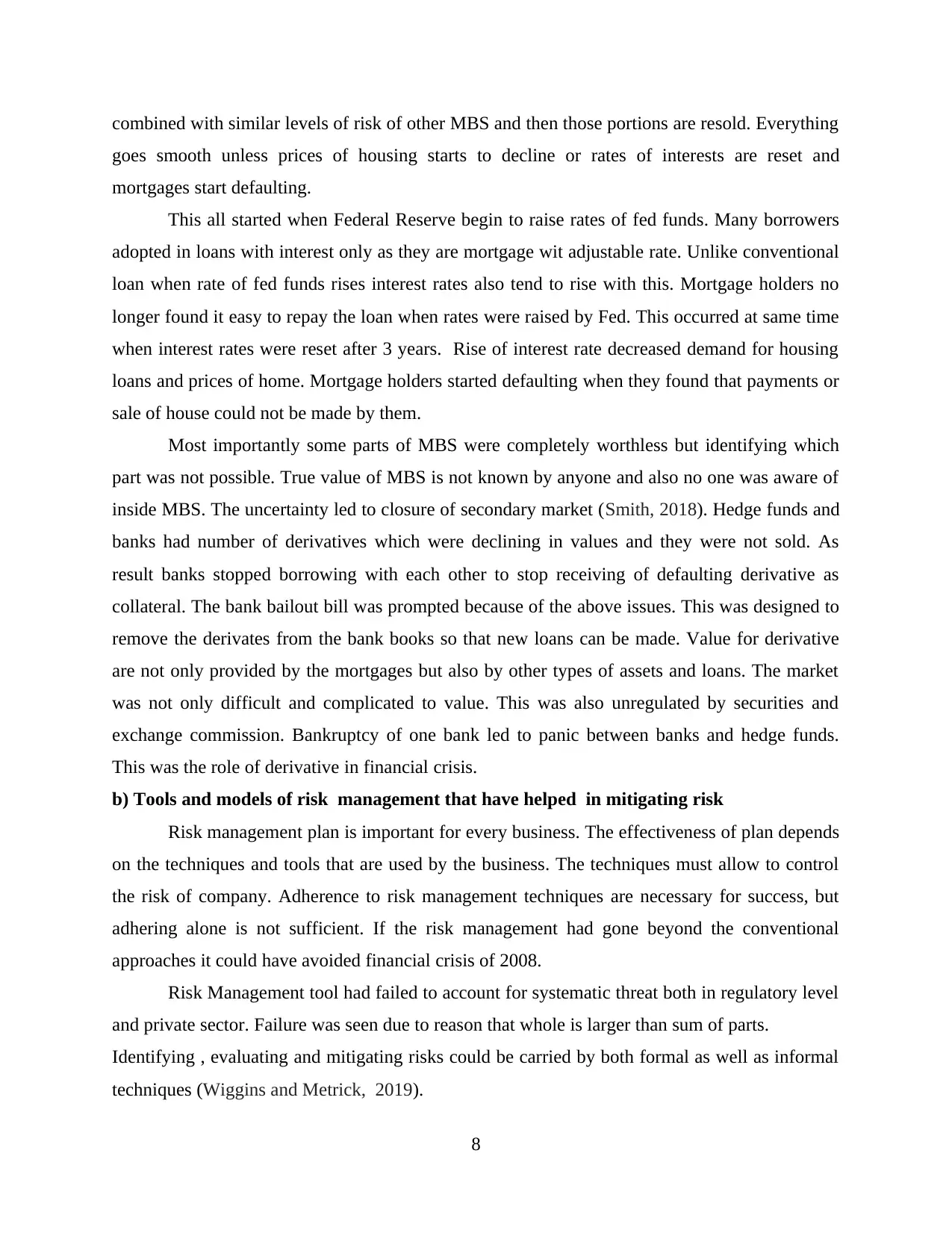
combined with similar levels of risk of other MBS and then those portions are resold. Everything
goes smooth unless prices of housing starts to decline or rates of interests are reset and
mortgages start defaulting.
This all started when Federal Reserve begin to raise rates of fed funds. Many borrowers
adopted in loans with interest only as they are mortgage wit adjustable rate. Unlike conventional
loan when rate of fed funds rises interest rates also tend to rise with this. Mortgage holders no
longer found it easy to repay the loan when rates were raised by Fed. This occurred at same time
when interest rates were reset after 3 years. Rise of interest rate decreased demand for housing
loans and prices of home. Mortgage holders started defaulting when they found that payments or
sale of house could not be made by them.
Most importantly some parts of MBS were completely worthless but identifying which
part was not possible. True value of MBS is not known by anyone and also no one was aware of
inside MBS. The uncertainty led to closure of secondary market (Smith, 2018). Hedge funds and
banks had number of derivatives which were declining in values and they were not sold. As
result banks stopped borrowing with each other to stop receiving of defaulting derivative as
collateral. The bank bailout bill was prompted because of the above issues. This was designed to
remove the derivates from the bank books so that new loans can be made. Value for derivative
are not only provided by the mortgages but also by other types of assets and loans. The market
was not only difficult and complicated to value. This was also unregulated by securities and
exchange commission. Bankruptcy of one bank led to panic between banks and hedge funds.
This was the role of derivative in financial crisis.
b) Tools and models of risk management that have helped in mitigating risk
Risk management plan is important for every business. The effectiveness of plan depends
on the techniques and tools that are used by the business. The techniques must allow to control
the risk of company. Adherence to risk management techniques are necessary for success, but
adhering alone is not sufficient. If the risk management had gone beyond the conventional
approaches it could have avoided financial crisis of 2008.
Risk Management tool had failed to account for systematic threat both in regulatory level
and private sector. Failure was seen due to reason that whole is larger than sum of parts.
Identifying , evaluating and mitigating risks could be carried by both formal as well as informal
techniques (Wiggins and Metrick, 2019).
8
goes smooth unless prices of housing starts to decline or rates of interests are reset and
mortgages start defaulting.
This all started when Federal Reserve begin to raise rates of fed funds. Many borrowers
adopted in loans with interest only as they are mortgage wit adjustable rate. Unlike conventional
loan when rate of fed funds rises interest rates also tend to rise with this. Mortgage holders no
longer found it easy to repay the loan when rates were raised by Fed. This occurred at same time
when interest rates were reset after 3 years. Rise of interest rate decreased demand for housing
loans and prices of home. Mortgage holders started defaulting when they found that payments or
sale of house could not be made by them.
Most importantly some parts of MBS were completely worthless but identifying which
part was not possible. True value of MBS is not known by anyone and also no one was aware of
inside MBS. The uncertainty led to closure of secondary market (Smith, 2018). Hedge funds and
banks had number of derivatives which were declining in values and they were not sold. As
result banks stopped borrowing with each other to stop receiving of defaulting derivative as
collateral. The bank bailout bill was prompted because of the above issues. This was designed to
remove the derivates from the bank books so that new loans can be made. Value for derivative
are not only provided by the mortgages but also by other types of assets and loans. The market
was not only difficult and complicated to value. This was also unregulated by securities and
exchange commission. Bankruptcy of one bank led to panic between banks and hedge funds.
This was the role of derivative in financial crisis.
b) Tools and models of risk management that have helped in mitigating risk
Risk management plan is important for every business. The effectiveness of plan depends
on the techniques and tools that are used by the business. The techniques must allow to control
the risk of company. Adherence to risk management techniques are necessary for success, but
adhering alone is not sufficient. If the risk management had gone beyond the conventional
approaches it could have avoided financial crisis of 2008.
Risk Management tool had failed to account for systematic threat both in regulatory level
and private sector. Failure was seen due to reason that whole is larger than sum of parts.
Identifying , evaluating and mitigating risks could be carried by both formal as well as informal
techniques (Wiggins and Metrick, 2019).
8

Identifying the risks
Banks should have successfully identified risks of possible eventuality. They would have helped
banks in identifying
Delphi technique refers to discussion between experts panel who would have deeply
identified the risks related to the derivative instruments in package. All the experts identified the
uncertainty of derivative instrument whose prices were falling with decline in housing prices.
Root cause analysis is another techniques that would have helped banks in getting the
root cause behind which the prices were falling. If the bank in mortgaged backed security had
identified that derivative instrument in the package could lead to losses to bank than they would
have not adopted MBS packages. Risks were not identified as credit worthiness of the borrowers
was not considered by banks.
Quantitative risk analysis
Techniques and tools are used for analysing numerically impact of risk on organisation.
They are quantitative techniques that are much complex. Sensitivity analysis have different
variables for introducing the impact on risks (Gupta, 2017). Financial crisis would not have
happened if the banks has identified the predictions that have failed to materialise. When the
rates of funds were rising than banks would have analysed the impacts of not properly analysing
the effects of fall in prices of the housing loan.
Qualitative analysis
Qualitative risks helps in analysing the risks that are to be focused by banks. Tools
include red green and amber that divides risks into categories depending on time impact and
quality. Risk categorisation helps in dealing with risks more effectively. Grouping risks in
different categories allows for coordinated approach for risks management. This would have
caused bank to segregate the risks in different categories (Prates and Fritz, 2016). Risks
associated with different home buyers should have been identified by the banks at time rates
were set high.
Risk Monitoring
After identifying the risks it is also essential to monitor the risks management plan so that
defaults could be avoided. In the financial crisis banks if had monitored the risk that could arise
in the process than it would have prevented the risks. This involves risk audit and status
meetings.
9
Banks should have successfully identified risks of possible eventuality. They would have helped
banks in identifying
Delphi technique refers to discussion between experts panel who would have deeply
identified the risks related to the derivative instruments in package. All the experts identified the
uncertainty of derivative instrument whose prices were falling with decline in housing prices.
Root cause analysis is another techniques that would have helped banks in getting the
root cause behind which the prices were falling. If the bank in mortgaged backed security had
identified that derivative instrument in the package could lead to losses to bank than they would
have not adopted MBS packages. Risks were not identified as credit worthiness of the borrowers
was not considered by banks.
Quantitative risk analysis
Techniques and tools are used for analysing numerically impact of risk on organisation.
They are quantitative techniques that are much complex. Sensitivity analysis have different
variables for introducing the impact on risks (Gupta, 2017). Financial crisis would not have
happened if the banks has identified the predictions that have failed to materialise. When the
rates of funds were rising than banks would have analysed the impacts of not properly analysing
the effects of fall in prices of the housing loan.
Qualitative analysis
Qualitative risks helps in analysing the risks that are to be focused by banks. Tools
include red green and amber that divides risks into categories depending on time impact and
quality. Risk categorisation helps in dealing with risks more effectively. Grouping risks in
different categories allows for coordinated approach for risks management. This would have
caused bank to segregate the risks in different categories (Prates and Fritz, 2016). Risks
associated with different home buyers should have been identified by the banks at time rates
were set high.
Risk Monitoring
After identifying the risks it is also essential to monitor the risks management plan so that
defaults could be avoided. In the financial crisis banks if had monitored the risk that could arise
in the process than it would have prevented the risks. This involves risk audit and status
meetings.
9
⊘ This is a preview!⊘
Do you want full access?
Subscribe today to unlock all pages.

Trusted by 1+ million students worldwide
1 out of 19
Related Documents
Your All-in-One AI-Powered Toolkit for Academic Success.
+13062052269
info@desklib.com
Available 24*7 on WhatsApp / Email
![[object Object]](/_next/static/media/star-bottom.7253800d.svg)
Unlock your academic potential
Copyright © 2020–2025 A2Z Services. All Rights Reserved. Developed and managed by ZUCOL.





